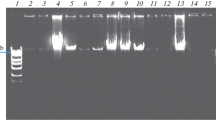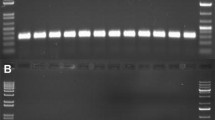Abstract
A series of simple and phenol-free silica-based protocols for isolating and cleaning RNA or DNA fragments from different sources were developed. Cytoplasmic RNA isolated from hybridoma cells by this method was used in RT-PCR. DNA fragments obtained using this protocol were suitable for further subcloning, gene transformation and DNA sequencing. © Rapid Science Ltd. 1998
Similar content being viewed by others
References
Barry, T, Geary S, Hannify S, MacGearailt, C, Shalloo, M, Heery, D, Gannon, F and Powell, R (1992) Nucl Acids Res 20:4940.
Boom, R, Sol, CJA, Salimans, MMM, Jansen, CL, Wertheim-van Dillen, PME and van der Noordaa, J (1990) J Clin Microbiol 28:495-503.
Carter, MJ and Milton, ID (1993) Nucl Acids Res 21:1044.
Chen, CW and Thomas, CA Jr. (1980) Anal Biochem 101:339-341.
Edmonds, M and Caramela, MG (1969) J Biol Chem 244:1314-1324.
Hengen, PN (1994) Trends Biochem Sci 19:182-183.
Hettwer, D and Wang, H (1989) Biotechnol Bioeng 33:886-895.
Sambrook, J, Fritsch, EF and Maniatis, T (1989) Molecular cloning: A laboratory manual. 2nd ed. Cold Spring Harbor Laboratory Press, Plainview, NY.
Vogelstein, B and Gillespie, D (1979) Proc Natl Acad Sci USA. 76:615-619.
Rights and permissions
About this article
Cite this article
Koo, K., Foegeding, P.M. & Swaisgood, H.E. Isolation of RNA and DNA fragments using diatomaceous earth. Biotechnology Techniques 12, 549–552 (1998). https://doi.org/10.1023/A:1008859632378
Issue Date:
DOI: https://doi.org/10.1023/A:1008859632378




